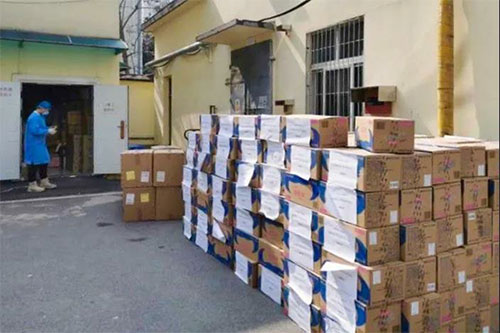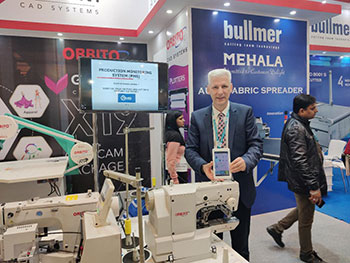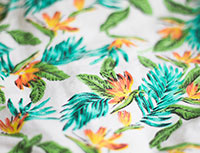FW
Gap has partnered with thredUP to encourage customers to exchange secondhand clothes for shopping credit at Gap, Banana Republic, Athleta, and Janie and Jack stores. thredUP is an online platform that partners retailers to support the circular fashion economy. It is the largest fashion resale platform in the world and upcycled its 100 millionth item in 2019.
Participants redeeming credits at Gap brands will receive an additional 15 per cent payout bonus. thredUP bags or labels will be available to customers at certain Gap, Banana Republic, Athleta and Janie and Jack stores in the United States, beginning in April. Gap, which currently diverts nearly 50 per cent of waste generated from its North American facilities, is working to divert more than 30 million pounds of material annually from landfills.
This is the latest in a long line of partnerships between thredUP and retailers. About 30 JC Penney stores offer a selection of secondhand women’s clothing and handbags. Each thredUP shop at JC Penney is thoughtfully curated and refreshed weekly to offer current fashion to shoppers. The platform has a 40-store pilot program with Macy’s. In October of last year, Madewell and thredUP partnered to sell secondhand jeans in Madewell stores in select markets.
Bangladesh’s major export sectors have been affected by the Coronavirus (COVID 19). Nearly 60 per cent fabrics of Bangladesh’s woven sub-sector are imported from China. Some 15 to 20 per cent raw materials and 80 to 85 per cent dyeing chemicals and accessories of the knitwear sector come from China. The supply chain of these items is already facing disruption. Each month Bangladesh imports some 200 containers of cosmetics and toiletries from China. Due to the virus outbreak import and shipment of these items have been suspended. Bangladesh also imports machinery and spare parts of the electrical merchandise manufacturing industry from China.
Other exports from China to Bangladesh consist of raw materials for the printing industry, containers of medical instruments and hospital equipment, raw materials and ready products of the eyewear industry, computer and computer accessories. Due to the supply chain disruption prices of raw materials, equipments, and accessories in Bangladesh have already started to go up.
Due to the virus outbreak both the domestic and export trade of China has come to a standstill. China is a top sourcing partner for Bangladesh. Any long lasting supply chain disruption with China can have a catastrophic impact on Bangladesh’s economy.
Aranya Natural, based in Kerala, produces natural dyed fabrics. The fabrics are produced by specially abled associates. Around 60 per cent of Aranya Natural’s products are sold abroad. Increased awareness has created a big market abroad for natural dyes and organic cotton clothes. Though they are expensive people especially in Europe feel children should be protected from chemicals and prefer such products.
Shrishti, s the promoter of Aranya Natural runs programs for the education training and rehabilitation of the differently abled children of tea plantation workers in Munnar, a hilly region in Kerala. Most commercial dyers in India ignored the nation’s wealth of local techniques, instead using potentially carcinogenic chemicals like azos that were harming the environment. No organization in the country had fully explored the area of natural dyes and the very few centers that made them didn’t follow environmentally sound processes. Shrishti adopted conscientious practices to create naturally dyed products that would ensure the survival of not only natural dyeing techniques, but also the livelihoods of the communities. It decided it would be the first movers in this space and build a model for responsible eco-friendly processes, quality, and providing well-paying employment to differently abled young people. So was incepted Aranya Natural in 1994.
The production growth of Face Mask is nothing short of a reflection of the China government’s efficiency, complete supply chain, logistics connectivity, first-aid responding system, and determination strengthened by brains and brawns to win the battle!

On February 24, Mr. Congliang, Secretary General of National Development and Reform Commission (NDRC) was invited to meet the news media at the press conference held by the State Council Information Office to introduce the updates for face mask supplies, with the issues relating to employment, finance, raw materials etc. in the companies that NDRC helped addressing.
Right now, there are 30 provinces, except Tibetan, with new production lines for face masks which went into operation one after another, and more lines are to be approved in the days to come. As of February 22, the daily output of face masks rose up to 54.77 million pieces, 2.8 times higher than that on the very first day of this month, amounting to 570 million pieces over the past 20 days.
The production growth is nothing short of a reflection of the government efficiency, complete supply chain, logistics connectivity, first-aid responding system, and determination strengthened by brains and brawns to win the battle. 
The Secretary General of NDRC told the reporters at the news briefing that the whole mission was carried out in two phases, and N95 face mask production was a primary consideration for the safety of the frontline doctors and nurses at the beginning. Great efforts were made to expand the production lines of this medical necessity with 919,000 pieces on daily count on February 22, 8.6 times as much as that on the start of this month. Over the past three weeks, 3.3 million N95 masks have been allocated through national instruction scheduling system from the provinces where the production of this special item is available, largely to the disease-ridden Wuhan city of Hubei province, also to Beijing and the other provinces with no N95 manufacturing. Actually, 2.68 million pieces went to Wuhan city where the daily supply of N95 can be shipped to at this moment, enough to meet the needs of over 60,000 medical workers fighting on the front.
As the factories start to resume operations here and there, workforces come back to work, this boosts the already tight supply up to insatiable shortage with an explosive demand growth. NDRC is shifting its focus on medical masks to civilian-purposed ordinary mouth muffles, accordingly in this new phase.
Contributed by Mr. ZHAO Hong
He is working for CHINA TEXTILE magazine as Editor-in-Chief in addition to being involved in a plethora of activities for the textile industry. He has worked for the Engineering Institute of Ministry of Textile Industry, and for China National Textile Council and continues to serve the industry in the capacity of Deputy Director of China Textile International Exchange Centre, V. President of China Knitting Industry Association, V. President of China Textile Magazine and its Editor-in-Chief for the English Version, Deputy Director of News Centre of China National Textile and Apparel Council (CNTAC), Deputy Director of International Trade Office, CNTAC, Deputy Director of China Textile Economic Research Centre. He was also elected once ACT Chair of Private Sector Consulting Committee of International Textile and Clothing Bureau (ITCB)
Accelerating Circularity, a new apparel industry collaborative project, announced the launch of its effort to accelerate the textile industry’s move from linear to circular. With figures from the Environmental Protection Agency showing that 15 million tons of textile waste is generated annually in the United States alone, the textile industry must move from a “take, make, waste” system to a circular one, in order to avoid the massive amounts of textile waste put into landfills annually. The Walmart Foundation provided a grant to Textile Exchange’s Accelerating Circularity Project. Gap Inc., Target, and VF Corporation are also funding the project and participating in a working group. The project is initially focused on researching, mapping and identifying opportunities to pilot circular supply chains which will be driven by the mechanical and chemical recycling of cotton, viscose and polyester textile waste. These three fibers cover over 80% of all textile fiber production and are therefore important to focus on in order to reduce textile waste. The Accelerating Circularity founding project partners include Gap Inc., Giotex, Gr3n, Target, VF Corporation, Lenzing, Unifi, Revolve Waste and Fabrikology International, Inc., representing technology providers, fiber manufacturers, and experts in textile waste and supply chains, as well as brands and retailers. “Shifting the apparel industry toward more circular solutions is a complex challenge with significant technical, economic, and business implications. At Gap Inc., we have a responsibility to protect the environment and reduce waste at every stage of our production process – from design, to sourcing, to manufacturing. As we address the full life cycle of our garments, we look forward to working with these partners to collaborate, advance efforts and share learnings with the wider industry for the health of our planet,” said Alice Hartley, Senior Manager of Sustainable Innovation at Gap Inc. and board member of Accelerating Circularity. Accelerating Circularity project partners are ensuring broad stakeholder representation by collaborating with industry organizations on this work including sharing information, amplifying key messages, and the streamlining of efforts.
 Based in Turkey, Gherzi is an independent, global firm of consultants, technical specialists, engineers, architects and planners working across all areas of industrial and infrastructure projects. Established over 5 years ago, the company focuses on garments. “We develop automatic training systems for our workers, reveals, Razvan Lonele, ATI Head-Garments Division of the company.
Based in Turkey, Gherzi is an independent, global firm of consultants, technical specialists, engineers, architects and planners working across all areas of industrial and infrastructure projects. Established over 5 years ago, the company focuses on garments. “We develop automatic training systems for our workers, reveals, Razvan Lonele, ATI Head-Garments Division of the company.
Involved in the development of IoT projects, enabling industry 4.0 compliance and digitalisation of garment factories, Gherzi collaborates with machine producers in Turkey. “We are the first European company to link machines with the server. We have collated thousands of machines with a server till date. These machines provide information on production in garment factories. This helps brands to predict and monitor their customers,” notes Lonele.
Being flexible, Gherzi systems can handle both big and small orders. “We can connect any machine on our web and get the complete package to support the management’s decision in the garment industry. We also deliver self-explanatory videos on a tablet. This helps thousands of people learn from our system,” adds Lonele.
Traditionally, the daily reports of workers were written by hand. There was no real time feedback. This also increased the possibility of human errors. “On the other hand, IoT reports can be generated instantaneously on a desktop or phone. This enables manufacturers to take fast decisions by allowing them to collect & collate information,” expounds Lonele.
This system increases productivity by 15 percent. The return on investment is up to a year. These solutions work in different countries and factories. “We don’t keep software in the cloud. We keep it in clients’ servers. This ensures data security.”
Gherzi started its Indian operations in 1960’s and has executed over 1,000 projects in the country. “Earlier, India used to be a textile industry, now garmenting is also growing,” adds Lonele.
The information provider to the global textile and apparel industry has announced the upcoming launch of Innovate Textile & Apparel Online – enabling knowledge exchange and networking continuity amid the Coronavirus outbreak
Innovate Textile & Apparel (ITA) Asia, originally scheduled to take place in Singapore in May, has been cancelled due to the Coronavirus outbreak, according to organisers WTiN. Instead, the information provider will organise a virtual conference that will enable delegates to access the presentations remotely across multiple devices. ITA Online will be available to stream from 5 May 2020 at midnight (GMT) until 30 June 2020. All presentations will be pre-recorded, with videos conveniently linked to the presentation slides. Users will be able to post questions to each presenter and can also participate in virtual networking opportunities.
Discussing the new format, Chinky Tyagi, head of Business Development, WTiN, says: “The WTiN team is following the development around the Coronavirus closely, and the health of our delegates and employees is of paramount importance to us which is why we made the decision to cancel ITA Asia for this year. However, rather than cancel the event altogether, we’ve pooled our expertise in digitalisation to offer a virtual solution: ITA Online. The online event will give attendees the opportunity to access all presentations in one go. They can watch presentations at their own pace with no extra cost of travel or accommodation; the virtual format aims to provide all the functionality of the in-person event including the networking.”
Innovate Textile & Apparel brings together strategic decision-makers determined to implement digitalisation in the textile and apparel sector. According to WTiN, ITA is more than a conference, but an experience that illuminates the emerging manufacturing technologies, material innovations and business models that are set to deliver the ‘next wave of opportunity’ for the global textile and apparel manufacturing community. As part of the Textile 4.0 track, registrants of ITA Online can access presentations on topics such as blockchain for creating an efficient supply chain, the digitally connected circular economy, skills evaluation in the digital age, 3D design and development and digital inspections. Re:Think Materials track will feature presentations on topics such as bio-graphene-infused textile fibres, the future of smart textiles, challenges in creating e-textiles, and the product development process for smart garments and wireless technology etc.
World Textile Information Network (WTiN) provides specialist insight and data-driven intelligence to businesses in the textile and apparel value chain, enabling them to make better decisions faster and gain competitive advantage. Its primary focus is on the high growth markets of materials innovation, industry digitalization and technical textiles.
"Its ability to print with bold colors in a precise and controlled manner makes screen printing an immensely popular method of production in the fashion industry. However, this method gained commercial popularity in fashion only after 1960s when the first rotatable, multicolor garment screen printing machine was developed in the US."
 Its ability to print with bold colors in a precise and controlled manner makes screen printing an immensely popular method of production in the fashion industry. However, this method gained commercial popularity in fashion only after 1960s when the first rotatable, multicolor garment screen printing machine was developed in the US.
Its ability to print with bold colors in a precise and controlled manner makes screen printing an immensely popular method of production in the fashion industry. However, this method gained commercial popularity in fashion only after 1960s when the first rotatable, multicolor garment screen printing machine was developed in the US.
Following the launch of digital printing machine, which enabled manufacturers to print logos on bowling uniforms, screen printing machines became the go-to technology for the fast-fashion movement, particularly as production moved to cheaper labor countries such as China and India.
However, high screen and screen storage costs of these machines along with their technological limitations restricts the use by designers. Some other barriers include: the labor-intensive work required in applying ink to screen to clothing; high-water consumption that arose from washing the screens; and the inability to design complex imagery with the screens’ mesh. To solve these issues, the industry needs to introduce innovative printing technology that offers greater flexibility and personalisation.
Although the popularity of screen printing continues to rise, digital printing can not only reduce environmental footprint but also enable greater flexibility, personalisation, and give designers the flexibility to experiment with their styles. Inkjet technologies can provide brands with high-resolution complex floral and animal prints alongwith details photorealistic visuals. Besides changing the way in which designers create garments, Inkjet printing also impacts fashion seasons, business models and supply chains.
footprint but also enable greater flexibility, personalisation, and give designers the flexibility to experiment with their styles. Inkjet technologies can provide brands with high-resolution complex floral and animal prints alongwith details photorealistic visuals. Besides changing the way in which designers create garments, Inkjet printing also impacts fashion seasons, business models and supply chains.
Transforming fashion cycles
Digital textile printing is also transforming the customary two-season fashion cycle as brands like Zara, a subsidiary of Inditex are launching collections all year rounds. Inkjet technology helps designers test and amend samples and designs on-the-spot by the designer, or print house, which helps to lower turnaround times.
Inkjet technologies help brands offer customised offerings to their customers. Brands can create apparels of greater variety and individuality with these technologies. Though initially, this technique was used for printing directly onto T-shirts but it now increasingly being used for other garments such as dresses and jeans. OEMs, like Israeli-based Kornit Digital, are also promoting the role of DTG printing in the home textiles sector.
A new beginning for digital transformation
As these technologies continue to proliferate in the global fashion and apparel sector, new business models and designs will continue to evolve. Though these technologies enable fashion and apparel markets to break down barriers and enable new possibilities, they also face certain challenges such as metallic or glitter inks and connecting the supply chain in the Fourth Industrial Revolution.
Thus streamlining production workflows, connecting digital textile printers with siloed processes both up and downstream will reduce the cost of printed fashion and apparel goods for the end consumer. It will also reduce proximity to the end consumer, improve lead times and create garments only when they are ordered.
A beginning of the digital transformation in the fashion and apparel supply chain, digital printing will never fully replace screen printing, However, it will transform the industry in terms of production, rebalancing power in the industry and increasing sustainability in the garment printing space.
Vietnam’s textile and garment export turnover to the EU is expected to increase by 81 per cent following the free trade agreement.
Enterprises are expected to enjoy plenty of room to expand into new markets due to the regulations setting out tax reductions. Most notably, in the context of unpredictable global developments such as trade protectionism, trade tensions, and the ongoing impact of the Coronavirus, the trade deal could help Vietnamese garment and textile firms boost their exports, diversify markets, and achieve higher value add through the establishment of fresh supply chains.
However, rules of origin are a barrier. In order to qualify for tariff exemption under the free trade agreement, companies will need to increase localisation of fabrics because the rules of origin are applicable from the fabric stage onward. But for Vietnamese companies, China cannot be replaced as the main supplier due to its much lower costs. A significant portion of the textile industry's feedstock is from China. Even when the delays in supply from China due to the coronavirus pushed them to look for raw material imports from other markets such as South Korea, India, Bangladesh, and Brazil, many saw this as nothing more than a temporary solution.
Micam was held in Italy from February 16 to 19, 2020. This Italian footwear trade show was attended by 1,205 exhibitors, closed with five per cent lesser number of visitors than last year. There was a noticeable absence of British and Asian buyers. Presentations, workshops, fashion shows, special installations and other initiatives dedicated to innovation were developed around three key themes for the industry: materials, sustainability and retail.
Micam is the leading international exhibition of the footwear industry. It is a unique event of its kind with footwear collections at each edition, successfully merging business and fashion. It confirms its role as a privileged stage for the promotion of new collections and, at the same time, a decisive business opportunity to forge contacts. Micam is a one-of-a-kind event with over 1700 footwear collections at each edition, successfully combining business and fashion. Participation is restricted to manufacturers, distributors, agents and representatives of the footwear industry. The exhibition is a unique visitor experience, with a host of collections bringing tradition, innovation and design to the fore. The format is aimed at exploring the transformation taking place in the shoemaking industry, from avant-garde materials to the most revolutionary consumer trends and from sustainability to new retailing methods. It is a focal point for guest speakers and innovative enterprises from all over the world.












